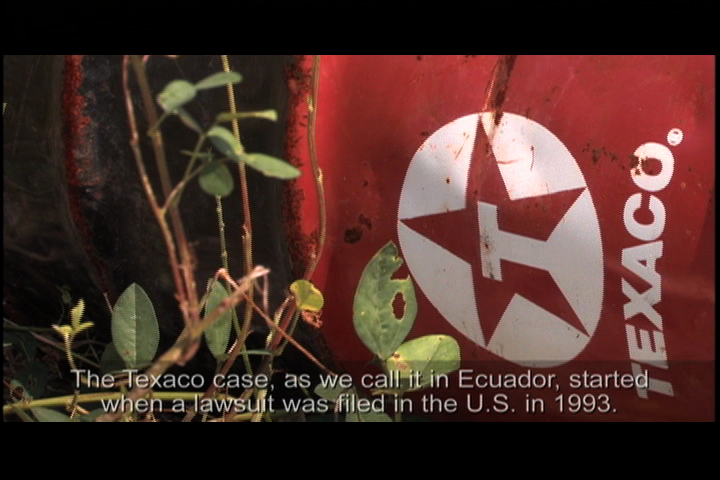On a chaotic street in this sweltering jungle town, Emergildo Criollo spent several days near the entrance to a courthouse that looks more like a run-down mall.
He was, he says, "vigilando" – watching.
"We waited to know the moment he arrived," says the middle-aged indigenous man who was raised in this oil-rich Amazonian rain forest near Ecuador's northern border with Colombia.
The man Mr. Criollo and his friends were waiting for is Richard Cabrera, a court-appointed expert who last week poured fuel on an epic environmental lawsuit filed by Ecuadorean indigenous groups against US-based Chevron-Texaco.
Mr. Cabrera, an Ecuadorean geological engineer, recommended to an Ecuadorean judge last Tuesday that Chevron pay $8 billion to $16 billion for environmental damages if the company loses a bitterly contested case that started in 1993 with a lawsuit in New York courts, which ruled that the case should be tried in Ecuador.
The Ecuadorean case, which Chevron has repeatedly rejected as flawed, is one of the largest environmental suits against an oil company and could raise the political risks for multinationals extracting resources from similar remote and pristine regions.
"The litigation is terribly important," says Professor Robert Benson, law professor emeritus at Loyola Law School in Los Angeles. "If Chevron loses the case there, certainly a historic precedent will be set putting oil companies on notice."
Plaintiffs call report a milestone
Texaco, bought by Chevron in 2001, operated as a minority partner in an oil venture with Ecuador's state-owned oil company, Petroecuador, from the 1970s to 1992, when Petroecuador took full control of operations. Chevron has long claimed that Petroecuador is responsible for the environmental damages.
Still, lawyers for the plaintiffs – who say Texaco dumped 18 billion gallons of toxic waste into unlined pits, rivers, and streams here – hailed Cabrera's report as a milestone.
"We consider the report to be very positive," says Pablo Fajardo, the plaintiff's lead attorney.
"After three years of hugely expensive 'he said, she said' environmental reports, this is a huge validation of the scope of contamination presented by the plaintiffs," said Aaron Marr Page, a lawyer who has worked with the plaintiffs.
But Chevron, which has long maintained that the lawsuit lacks credible scientific evidence and that Texaco was released from liability by Ecuador's government years ago after a $40 million remediation campaign, attacked the report and its author.
"We consider the report null and void because it is the result of irregular processes that do not conform with court orders," Ricardo Reis Veiga, managing counsel for Chevron Latin America, said in a telephone interview.
Mr. Veiga said Chevron attorneys had been denied the chance to inspect the qualifications of the technical experts who helped Cabrera write the report. He also said Cabrera overstepped his judicial mandate to simply confirm any petroleum-related environmental damage by assessing culpability and assigning monetary values – a job Chevron says rests with the judge.
In a statement last week, Chevron said it will ask the Supreme Court of Lago Agrio to dismiss the report.
Veiga also accused Cabrera of improperly collaborating with the plaintiffs, saying that the company has evidence, including videotapes, that his technical team received logistical support from a group called Amazon Defense Front, a civic group that backs the plaintiffs and that would receive and disburse a portion of any payments.
The lawsuit's political tone
The lawsuit has taken on a political tone in both the US and Ecuador.
Ecuador's leftist president Rafael Correa, who came to office in 2006 on a platform involving promises to renegotiate oil contracts in Ecuador's favor, has said that the oil damage allegedly caused by Texaco is much greater than the 11-million gallon Exxon Valdez spill off the Alaskan coast in 1989.
In February, Sens. Barack Obama (D) of Illinois and Patrick Leahy (D) of Vermont sent a letter to US Trade Representative Rob Portman urging him to ignore an apparent campaign by Chevron to exclude Ecuador from trade negotiations until the Ecuadorean government shuts down the lawsuit. "While we are not prejudging the outcome of the case, we do believe the 30,000 indigenous residents of Ecuador deserve their day in court," the senators wrote.
It's unclear what will happen in this increasingly bitter lawsuit.
What's beyond dispute, however, is that the rain forest bears indelible ecological stains. Streams in the area are topped with shimmering layers and pastures are covered with sludgy soil smelling of diesel.
Impoverished locals interviewed for this story are suffering illnesses that they blame on oil contamination. Chevron has denied causal links between illnesses and Texaco's operations.
Lawyers are increasingly going after US-based oil companies for alleged crimes committed overseas.
In 2005, in Doe v. Unocal, the California-based oil company agreed to a settlement after being sued for collaborating with Burmese military personnel in the torture and murder of Burmese villagers. A pending case, Bowoto v. Chevron, accuses Chevron of collaborating with Nigerian forces alleged to have killed indigenous oil opponents. And the Peruvian Achuar people are suing Occidental Petroleum for alleged environmental and health damages left in Peru's oil-rich northern Amazon. That case, filed last year in California court, is also pending.
"The sheer scale of this damages assessment sends out a powerful message to the oil industry and to other extractive industries; times have changed," says Simeon Tegel, a spokesman for California-based group Amazon Watch, which is backing plaintiffs in the case. "You can no longer expect to get away with using negligent environmental practices in the Amazon or anywhere else in the developing world and get away with it."
Reproduced with permission from The Christian Science Monitor.
Listen to a two-minute audio interview with Kelly Hearn.





